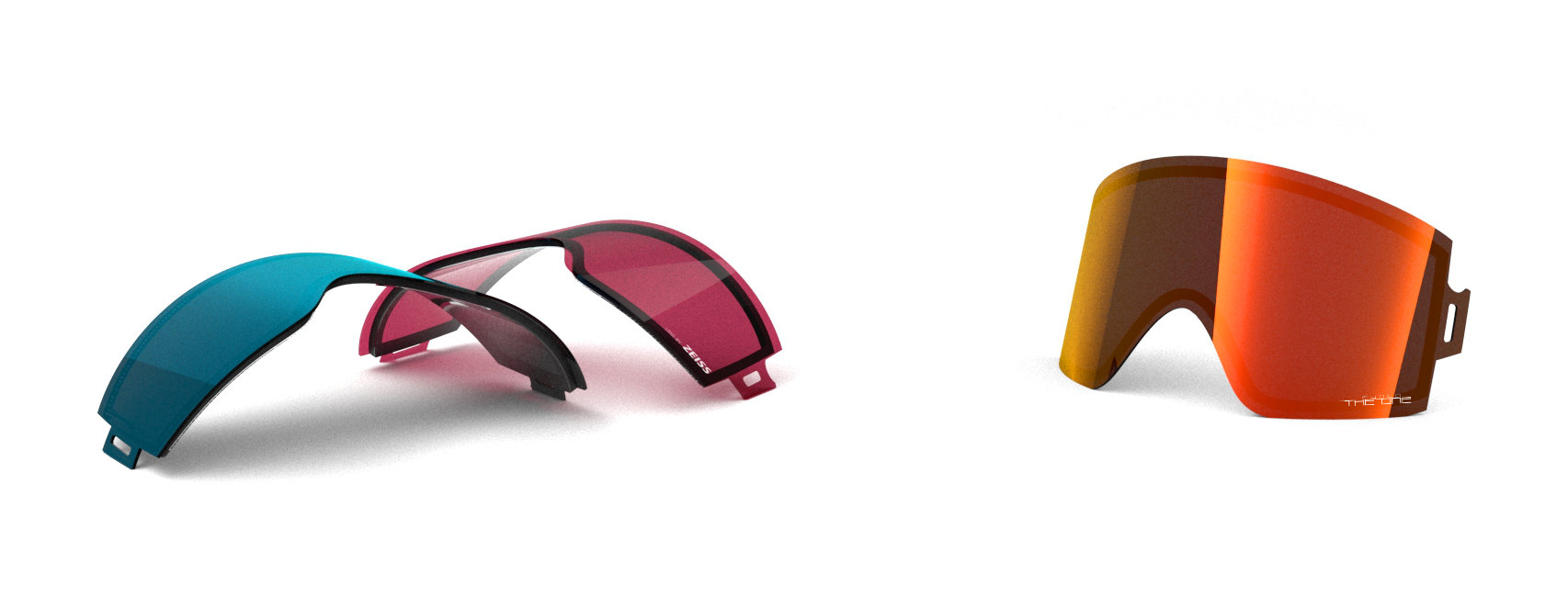OUT OF Goggle Katana Tempesta Red MCI Bonus Persimmon
6 seconds lens interchange system

The Katana has a lens interchange system that is easy to use and incredibly quick. If the clouds suddenly decide to ruin a bluebird day, you can be ready with the perfect lens in just a few seconds.
You just need to open the lever on the left side of the goggle, lift the lens on the side of the lever to free it, and there you go: you're done.
Two Zeiss lenses or the mythical The One

The Katana is available with two Zeiss lenses, one for sunny days and one for bad weather conditions.
In alternative, you can choose to have it with the awesome The One photochromic and polarized lenses that are designed to work well in all conditions.
More field of view without the frame

The Katana's frame doesn't protrude from the sides of the lens, improving the field of view on the vertical axis; therefore, providing a better vision at the top and at the bottom of the lens. On the sides the frame hosts the quick lens interchange mechanism.
Lente principale: Red mci
- Red/orange mirroring, cold transparency
- S2
- Ideal for: Variable weather, slightly sunny days
Lente secondaria inclusa: Persimmon
- Clear orange transparency, no mirroring
- S1
- Cloudy or with snowfall or foggy days
Altre caratteristiche
 Super quick lens interchange system (6 seconds)
Super quick lens interchange system (6 seconds)
 Inner silicone grips with fading texture on the strap's inner side
Inner silicone grips with fading texture on the strap's inner side
 Cylindrical lens
Cylindrical lens
 Dual-Frame construction
Dual-Frame construction
 Optimized fitting
Optimized fitting
 Helmet compatible
Helmet compatible
 Microfiber pouch included for protection and cleaning
Microfiber pouch included for protection and cleaning
 Full perimeter ventilation
Full perimeter ventilation
 100% UV protection
100% UV protection
 Field of view: 196° horizontal, 4.93 solid Sterads
Field of view: 196° horizontal, 4.93 solid Sterads
 Foam: Hypoallergenic triple density with moisture wicking fleece
Foam: Hypoallergenic triple density with moisture wicking fleece
 Double layer anti-fog lens: yes
Double layer anti-fog lens: yes
 Anti-fog treatment (standard 8 sec.): 77 sec.
Anti-fog treatment (standard 8 sec.): 77 sec.
 Dimensions:173mm x 99mm x 77mm
Dimensions:173mm x 99mm x 77mm
 Weight: 122g
Weight: 122g
The "optimized" second lens

Almost all Out Of goggles include a second lens for bad weather conditions. Often this second lens isn't considered important, but it's during rainy, soggy, cloudy or foggy days that the right lens can really make the difference.

The Storm has been developed thanks to hudreds and hundreds of spectrophotometry measurements (made by the department of physics of the University of Milan) taken at high quotes, in places without trees, during cloudy, snowy and foggy conditions. The ones just described are the hardest conditions a skier might find in the mountains because the light refraction makes it hard to perceive the shape of the ground.
Since we always give two lenses for each goggle, we were able to develop an extremely specific lens that is, therefore, very effective.
How does it work?

When the sky is covered and we're surrounded by snow, everything seems to us like a white, even mass. To our brain the areas of the snow that are illuminated and the ones that are in the shadow are practically identical. Yet, if we analyze the light in those two points with a spectrophotometry, we discover that they are not identical.
There are, in fact, wave lengths in which the differences are greater, and others in which the differences are less evident.
The optmized lens Storm filters the light eliminating those wave lengths in which the differences are slight, while it allows the one in which the differences are greater to hit the eye, improving the perception of the ground.
So why only one lens is made like this?

An optimized lens modifies the colors of the image to increase contrast, but this contrast boost isn't always needed.
During sunny days it's actually preferable to have a more natural perception of the colors since the perception of the shape of the ground isn't an issue. In this way your eyes will be relaxed avoiding annoying complications such as headaches or tired eyes in the evening after a whole day of skiing.
In collaboration with the department of physics of the University of Milan

The Storm lens is the result of a research program made in collaboration with the department of physics of the University of Milan.
The great knowledge and expertise of the researches involved allowed us to gather a great amount of data on field. This data was fundamental to develop a mathematical model that defined, in every single aspect, the absorption spectrum of the lens.
Impact Shop OUT OF Official Dealer
OUT OF Goggle Katana Tempesta Red MCI Bonus Persimmon



